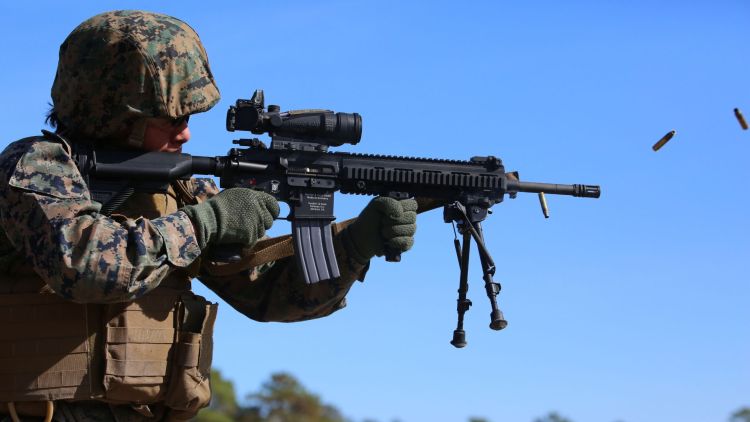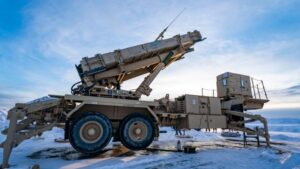Looks like the US Marine Corps is on the hunt for cutting-edge technology to turn its infantry into drone-killing machines.
The service has issued a call for proposals, published on July 15, seeking attachments that can transform the M27 Infantry Automatic Rifle into a formidable counter-drone weapon.
21st-Century Battlefield Problem: Countering the Drone Threat
The battlefield is constantly evolving, as you may already know, and with it, so is the nature of threats.
While counter-drone technology has been in focus recently, the challenges posed by unmanned aerial systems (UAS) continue to grow.
The proliferation of drones, once a tool exclusive for reconnaissance and surveillance, has morphed into a potent weapon capable of delivering explosives, conducting electronic warfare, or simply disrupting operations.
Its utilization and importance in the battlefield have explicitly been magnified in the ongoing war between Ukraine and Russia.
To counter this growing menace, the Marine Corps is looking to equip its ground troops with the ability to detect, track, and neutralize hostile UAS.
High-Tech Attachments: Infantry to Become Drone Hunters
The envisioned attachments will include a suite of high-tech capabilities, such as radio frequency and GPS jammers to disrupt drone communications, advanced optics for precise targeting, and potentially even specialized ammunition designed to take down these aerial threats.
Importantly, these systems must be rugged enough to withstand the rigors of combat and operate effectively in a variety of weather conditions.
Marines engage known-distance targets with the M27 IAR during a field exercise. (DVIDS)
Squad and Platoon-Level Solutions
The Marine Corps is seeking solutions for both squad and platoon-level units.
Smaller squad-sized elements may be equipped with less complex systems, such as directional jammers and passive detection devices.
Squad-level counter-drone capabilities should include:
Passive Detection: Systems that can identify drones using sound (acoustic) or radio signals (RF). These sensors should be wearable without hindering the soldier’s primary duties. Alerts, warnings, or notifications would be relayed through devices like tablets, smartwatches, earpieces, or smart glasses, which receive data from external sensors such as radar or passive detection systems.
Non-Kinetic Jamming: Equipment that can disrupt drone communications by interfering with RF and GPS signals. Ideally, this jammer would be small enough to attach directly to the soldier’s rifle.
Kinetic Defeat: Rifles or rifle-mounted optics designed to track and destroy small drones. Specialized ammunition, similar to buckshot but in calibers like 5.56mm, 7.62mm, .50 caliber, or .40 caliber, could be employed for increased effectiveness.
Meanwhile, larger platoon-sized elements could field more sophisticated, omnidirectional jamming equipment and advanced sensors.
Platoon-level solutions may include:
Passive detection systems: Capable of identifying drones through sound (acoustic) or RF. These systems can be mounted on vehicles, poles, or tripods.
Alert systems: Soldiers can receive warnings, notifications, or alerts through wearable devices like tablets, smartwatches, earphones, or smart glasses. These devices will connect to external sensors like radar or passive detection systems.
Jamming technology: Devices that can interfere with a drone’s RF or GPS navigation.
Weapon enhancements: Modifications to existing rifles or rifle scopes to improve the ability to track and shoot down small drones. This could include specialized ammunition designed for better impact on drones.
In addition to describing their systems’ capabilities, interested manufacturers should include the following characteristics of their proposed system in their white paper.
Mechanical Design
Environmental Design
Interoperability: adhere to relevant industry or military standards to ensure seamless integration with other systems
Performance: effectiveness in detecting, tracking, and defeating Group 1 and 2 UAS targets
Logistics: including detailed Reliability, Availability, and Maintainability (RAM) metrics, among many others
Compliant with all relevant safety standards
Procurement (cost estimate and production capacity, among many others
Cybersecurity (capable of NSA-level encryption) and resiliency against cyber threats
M27 Infantry Automatic Rifle (DVIDS)
Wrapping Up: By investing in this technology, the Marine Corps aims to provide its troops with a critical edge in the evolving battlespace. With the potential to transform the humble infantry rifle into a drone-hunting platform, this initiative represents a significant step forward in the ongoing fight for technological superiority.
And who knows, one day you may see drone-shot on the shelf of your local sporting goods store.
—
Disclaimer: SOFREP utilizes AI for image generation and article research. Occasionally, it’s like handing a chimpanzee the keys to your liquor cabinet. It’s not always perfect and if a mistake is made, we own up to it full stop. In a world where information comes at us in tidal waves, it is an important tool that helps us sift through the brass for live rounds.



